Google Selected for 8th Annual International Design Awards
NELSON’s Boston office was awarded Gold in Interior Design Competition by the 8th Annual International Design Awards for the Google, Cambridge Campus Expansion, Massachusetts Project.
IDA honorary juries examined over 1000 entries submitted by architects and designers of interiors, fashion, products, and graphics from 52 countries throughout the world. After final decisions had been made, the jury rewarded the best professional and emerging designers for their achievements in terms of design, creativity, usability and innovation. Judging was a rigorous process, with winners receiving publication of their work in the International Design Awards Book of Designs. The coveted IDA Trophy will be awarded to all Designer of the Year title winners at the official biennial International Design Awards Ceremony in Los Angeles.
This annual competition recognizes, honors, and promotes legendary design visionaries and uncovers emerging talents in Architecture, Interior, Product, Graphic, and Fashion Design on global level.
The members of the jury included Alice Blackwood Editor, Design Quarterly, Kahi Lee – Host, HGTV’s “Design on a Dime”, Style Network’s “My Celebrity Home”, Melissa Sterry – Interdisciplinary Design Scientist, Founder, Societas,Josh Rubin – Editor-in-Chief, Founder, and Publisher, Cool Hunting, Martin Venzky – Stalling, Senior Advisor, CMU STeP, Jeffrey Nemeroff – Co-Founder, Creative Director, Entra Magazine, Jordan Landes-Brenman CEO, Haute House PR & Marketing, Raj Nandan – Managing Director, Indesign Group, William Menking – Founder, Editor-in-Chief, The Architects’ Newspaper, Nicole Lloyd – Senior Art Buyer, Deutsch, Inc., Rebecca Epstein Kong – Co-founder, Artware Editions, Aaron Kenedi – Editor-in-Chief, Print, Geraldine Grisey – Editor, Punky B Fashion Diary.
PROJECT DESCRIPTION
Google came to NELSON in 2010 looking to design 20,000 SF of office and kitchen/café space. This modest beginning rapidly grew into a 1200-person, multi- building ‘campus’ located in the MIT Kendall Square area of Cambridge, MA. Paramount to the project’s success was the connection of three buildings surrounding a parking garage with two purposefully built infill buildings forming the nucleus of Google’s campus. Google’s corporate design strategy includes creating spaces that reflect each location’s history and character. Visioning sessions held with ‘Googlers’ resulted in a master plan concept based on Boston’s iconic MBTA transportation system, the “T.” Each building is assigned a color coded ‘line’ and each floor a ‘stop.’ Inspired and guided by the stop’s surrounds, the goal was to create a Boston/Cambridge office. Highlights include a Red Line “Kendall Square” stop as the main entrance. Visitors arrive inside a Red Line subway car, setting up the overall campus experience. Other stops include a micro kitchen with real canoes referencing boating on the adjacent Charles River. At “Charles/MGH” Red Line floor, the luxury Liberty Hotel riffs off of the former infamous Charles Street Jail, mixing lavish appointments with real jail cell doors. A Back Bay Victorian row house library pays homage to the Green Line “Arlington Street” stop, but with a modern twist. The historic “Park Street” floor offers an inspired cafe with rooftop garden views interpreted as the Boston Public Gardens. And, at America’s first public beach – the Blue Line’s “Revere Beach” celebrates with a lighthouse and lounge. Nothing is too outrageous to picture, and one-size-fits-all workstations compliment an array of amenities fostering productive ‘alone’ time as well as collaboration. While innovation and creativity are crucial, Google’s metric focus insures that everything meets data-driven criteria. Google has global commitment to sustainability and spaces are LEED Gold or Platinum Certified.
Please join us in congratulating the Boston Team!
Doug Larson Joins NELSON Worldwide as Senior Project Manager, Workplace
Doug Larson has joined NELSON as Senior Project Manager, Workplace. Doug will collaborate with and provide guidance and support to the workplace team on projects varying in size and scope through all stages of design.
Doug brings more than 30 years of experience delivering interior design workplace services for the financial, aviation, and property management sectors. He is passionate about his clients and commits to thoroughly understanding their business requirements and drivers, allowing him to consistently deliver distinct design solutions while maintaining the project’s objectives and establishing long-term relationships with clients and project teams.
As a Certified Interior Designer, Doug enjoys establishing and fostering long-term relationships with clients and fellow teammates. He believes building a strong culture of delivering solutions, growing individuals, gaining friendships, and having fun along the way is fundamental. Having a personal infatuation with commercial aviation and aircraft, a highlight of his career was managing the design of the new Sun Country Airlines headquarters and in-flight training facility. This included integrating office space into a former maintenance hangar with the stipulation that the space be able to turn back into a hangar at lease end, offering a unique challenge.
Joe Pobiner Joins NELSON Worldwide as Regional Practice Leader, Mixed-Use
Joseph Pobiner has joined NELSON as Regional Practice Leader, Mixed-Use. Joe will work closely with national leadership to expand the firm’s Mixed-Use practice with a focus on the Texas and Southwest markets. Additionally, Joe will serve as a firmwide planning and urban design resource.
Throughout his illustrious career, Joe has been involved in a wide array of projects, spanning diverse markets including healthcare, hospitality, corporate and university campuses, mixed-use developments, sports and entertainment venues, civic projects, and residential developments. Notable among his accomplishments are his contributions to signature projects such as NFL stadiums and other major league venues, comprehensive plans for communities across Texas and the United States, as well as master plans for cities in Latin America and the Middle East.
Prior to joining NELSON, Joe garnered esteemed recognition for his contributions to the planning and urban design field. In 2010, Joe was inducted into the American Institute of Certified Planners’ College of Fellows – the highest honor bestowed on professional planners. Furthermore, his distinction as a Distinguished Alumnus of The Ohio State University in 2012 solidified his reputation as an influential figure in the industry, making him only the second planner to receive this honor (at the time) since its establishment in 1954.
Joe currently serves on the Board of Directors of the Congress of the New Urbanism’s (CNU) North Texas Chapter. In the past, he held the position of US President of the International Society of City and Regional Planners (ISOCARP) and contributed his expertise as a valued Board member of the American Planning Association’s (APA) Texas Chapter. Joe’s profound impact on the industry, combined with his extensive knowledge and leadership experience, make him an invaluable addition to the NELSON team.
On The Horizon: Airport Trends of the Future
As the world continues to rapidly shift in the wake of the pandemic, the travel industry has a unique opportunity to leverage this lull to reimagine the passenger experience. Not only to create resilient environments that provide guests with confidence and control, but offer travelers a compelling experience that’s as memorable and engaging as their final destination. From the retail offerings, to unique, differentiated amenities, an airport that distinguishes itself from the rest will have a competitive edge for years to come.
#1: Authentically Local
Consumers are traveling with a desire to experience cultures different from their own. Airports have the opportunity to use this desire to their advantage and offer unique experiences that immerse travelers in the locale, both at arrival and departure. Going beyond simple aesthetics, airports should find ways to offer meaningful community support or partnerships to create a sense of place and cultural appreciation. Set the bar high with exclusive experiences that set the tone for their travels, and leave visitors craving more.
[ngg src=”galleries” ids=”21″ exclusions=”125,126,129,130,133,135,137″ display=”basic_imagebrowser”]
Far Horizon:
World cultures integrate themselves into the airports
- GLOBAL PORTALS: Gates develop augmented reality windows that act as “portals” to the destination. Travelers can interact with people at their destination and vice versa.
- LOCALIZED FARE: Chain restaurants are replaced by concepts that bring the local flair into the traditionally homogenized airport environment.
- EXPERIENCE CULTURE: Rentable pods within the airport are available to travelers that immerse themselves in the culture of various destinations, e.g. karaoke pods to help represent Japanese karaoke culture.
#2: Creating an Ecosystem
Airports must evolve to become more self-sufficient environments that enable travelers to have more control over their experiences. As expectations of service and amenities have accelerated during the pandemic, airports of the future must become more convenient, functional, and efficient developments to meet consumer demands. Unlike struggling malls, airports have a constant source of captive traffic, so the focus will shift from making money from airlines, to making money from the passengers in terms of commercial revenue, through more service-based offerings.
[ngg src=”galleries” ids=”22″ display=”basic_imagebrowser”]
Far Horizon:
Airports and the areas surrounding them become self-contained cities
- PACK LESS: Consumers no longer pack for their trips as they rent clothing from sources like Rent The Runway and pick up their options in the airport upon arrival.
- MOBILE EATS: UberEats or similar partnerships allow for mobile food orders to be delivered to locations within the airport or set for pick up at a gate before or after a flight.
- SERVICE BOOM: Elevated amenities that have become a commonplace during COVID-19 like food delivery, meal kit pickups, or streaming on-demand fitness become expected airport offerings.
#3: Elevated Experiences
Many travelers will embrace the ‘Travel Less, Travel Better’ mantra in the coming months and years, being more discerning with their plans while looking for opportunities to upgrade the experience. From business travelers to jet-setting millennials, airports can appeal to this need by offering exclusive amenities that cater to this growing market looking for premium, private, or unique perks.
[ngg src=”galleries” ids=”23″ display=”basic_imagebrowser”]
Far Horizon:
Travel may be less frequent, but guests will look for premium offerings
- CONVENIENT COLLECTING: Gate pods will deliver items such as toiletries, food, or other necessities so travelers don’t need to carry them or include in their carry-on bag.
- THE NEW VIP: As the areas around airports develop with restaurants and entertainment options, services derived from hospitality spaces will become more common – including expedited transportation packages for users with security clearance from restaurant/hotel–to–gate.
- PREMIUM PRIVACY: Business and luxury travelers will look for more private spaces to relax and recharge away from the crowds – think nap pods, exclusive lounges, and private spa offerings.
#4: Holistic Health
WELL-certified environments have grown increasingly popular in recent years and that desire will only accelerate post-pandemic. Travelers will be looking for both visual and non-visual cues that an airport is fresh, clean, and safe. Providing more spaces that encourage holistic wellness will go a long way in strengthening guest confidence. From indoor gardens, to rooftop lounges, to private meditation rooms, airports will need to cater to stressed travelers looking for an opportunity to relax and recharge in a safe environment.
[ngg src=”galleries” ids=”24″ display=”basic_imagebrowser”]
Far Horizon:
Emerging wellness trends become mainstream and easily accessible
- THE GREAT OUTDOORS: Secure, outdoor space will become an expected offering for passengers – from outdoor dining facilities to public rooftop pavilions.
- ELEVATED TRACKS: Indoor tracks that are elevated above the terminal are accessible to those who want to exercise without being confined.
- SENSORY FITNESS: Immersive rooms can be rented out and change in theme to leave the user feeling transported and provide additional health benefits.
#5: Adaptive Environments
As touchscreen technology continues to decline, travelers will rely on their mobile devices to help navigate their journeys. This provides an excellent opportunity for airports to become the true curators of the passenger experience. From check-in, to dining, to entertainment, airports can utilize adaptive technology with inputs from mobile devices to make the experience more relevant and meaningful. The ability to create dynamic experiences through environments that adapt to consumer mood, flight schedule, location, and even weather, will be a true differentiator.
[ngg src=”galleries” ids=”25″ display=”basic_imagebrowser”]
Far Horizon:
Customers regain control of each step in their travel experience
- FLEXIBLE FURNITURE: Gates have flexible seating that changes based on the type of traveler coming through – conversational layouts for families or individual seating for solo travelers.
- PERSONALIZED ENVIRONMENTS: Consumers have the ability change their own environments in seating locations including the heat, airflow, and even aromatherapy scent.
- THEMED ZONES: Gates and terminals develop themes through lighting, seating styles, and digital graphics that adapt to the time of day, season, and flight destinations.
#6 Cultural Influencers
From sustainability initiatives to social movements, airports have a unique opportunity to be part of the conversation. Leveraging a captive audience and an expansive platform will fuel partnerships with private brands, local government, or even non-profits to bring a unique environment and message to life. These temporary activations not only create an exclusive destination but can also be an opportunity for new revenue streams, premium experiences, and PR buzz.
[ngg src=”galleries” ids=”26″ display=”basic_imagebrowser”]
Far Horizon:
Becoming a more socially-minded platform
- BRANDED EXPERIENCE: Gates or terminals have brand sponsors, creating unique environments that celebrate their product or service, relevant to travelers.
- TARGETED FUNDRAISING: National agencies like the National Park Service provide unique activations within applicable airports that can bring awareness or funds to their cause.
- SOCIAL VOICE: Messaging in support of various social causes will be implemented within airports giving these initiatives a more global stage.
Our Return to the Great Outdoors: Fueling the Outdoor Lifestyle
From retail destinations, office amenities, new services, and sustainable design, we’re seeing a surge in the desire to reconnect with the great outdoors across every consumer-facing environment. In our latest series, Our Return to the Great Outdoors we’ll share how brands can embrace this trend to create both safe and memorable outdoor experiences that will resonate with consumers long after COVID-19 fades.
In times of uncertainty, consumer expectations don’t change completely—they simply evolve, pivot and accelerate, raising the bar and amplifying the demand for new, relevant experiences. In 2020, a major shift in consumer behaviors welcomed an uptick in outdoor recreation. With health in mind and a new appreciation for wide open spaces, consumers and developers have turned their focus to sustainable environments that are connected to nature. In the third and final part of this series, we’ll be exploring elements that enhance this connection through amenities, services, or new standards:
Outdoor Activities
According to Outdoor Industry Association, Americans have flocked to outdoor recreation amid COVID-19 restrictions limiting indoor experiences. Across the country, hiking and camping sites have reported their busiest months in years, and according to the N.P.D Group, the sales of leisure bikes have jumped 121 percent. With this at play, it seems active, outdoor lifestyles are here to stay. There are many ways brands and businesses across all sectors can create environments that this complement trend including adding bike repair shops and storage to properties or introducing outdoor focused products/services.
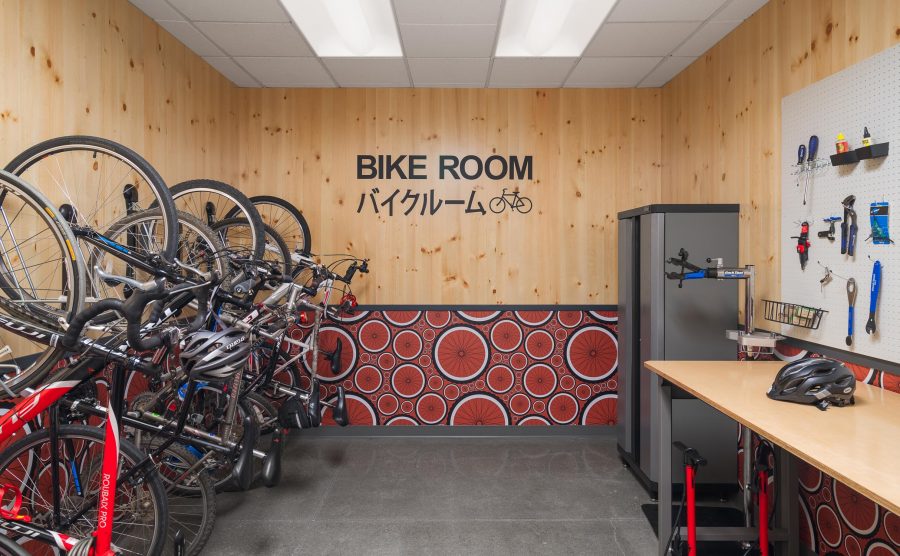
Seasonal Solutions
As the seasons change and COVID-19 remains, brands and business will have to adjust to new weather. Even with safety concerns, many consumers will want to continue shopping in-store, dining out, and enjoying the outdoors. For restaurants, outdoor spaces will have to be winterized and property managers will have to develop outdoor amenities that that support year-round engagement (e.g. Astroturf, outdoor fire pits, or green space that can be a pop-up playground in the summer and an ice rink in the winter).

Simulating the Senses
Even for completely indoor environments, there are many ways the outdoors can be brought inside to cater to consumers new found appreciation of nature. This can be accomplished by:
- Adding sound machines, greenery, and natural materials to a space, whether it is part of a shopping, living, or working environment
- Creating environments that have greater access to natural light or easy access to the outdoors via doors and functional windows
- Prioritizing WELL-Certified environments to build more sustainable spaces that promote overall health and wellbeing
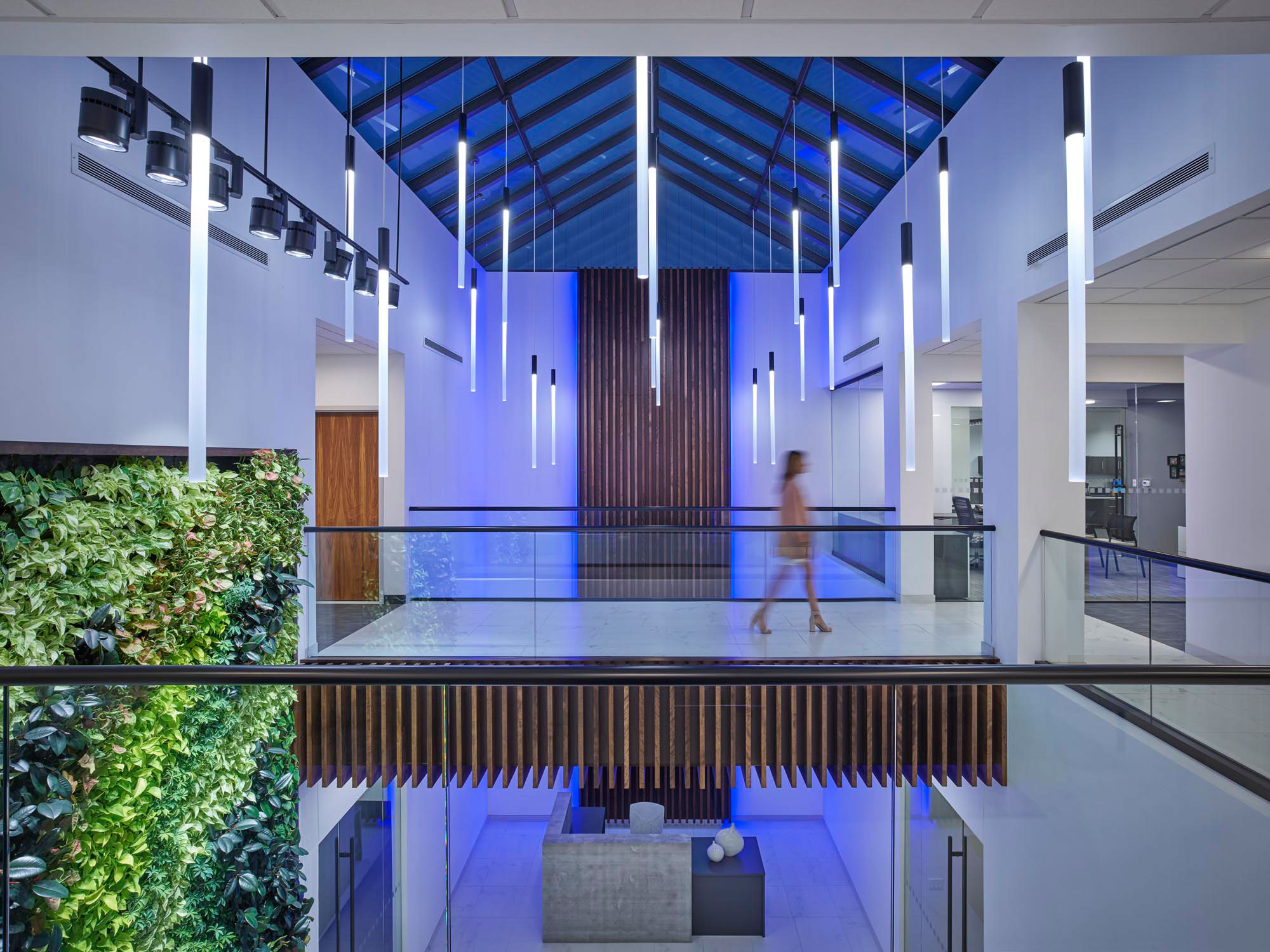
AIS Headquarters
Overall, consumer behaviors prove that outdoor spaces are worth the investment. Whether it’s incorporating amenities and resources to make outdoor activities more assessible, creating flexible spaces that can easily be transformed for seasonal outdoor use, or adding outdoor flair inside, give consumers what they want and help them better connect with the great outdoors.
Six Byproducts of COVID-19 that will Influence Multifamily Living
Since the onset of COVID-19, we’ve seen many creative solutions as it relates to the built environment. The problem is, most of these solutions lack longevity and sustainability. Quick fixes and band-aid solutions may make an impression now, but it’s critical that we create environments, not based on knee-jerk reactions. We must instead focus on changing consumer behaviors, and the longer-term byproducts of the pandemic that will forever change the way we engage with the world around us.
There will be six longstanding byproducts of COVID-19 that will greatly affect the most desired multi-family amenities: heightened appreciation for socialization, increased demand for e-commerce, the transition from work-life balance to work-life unity, and enhanced expectation for convenience.
Socialization Side-Effect
Even if people aren’t comfortable being physically close to others, there will still be an overwhelming yearning for socialization. Tapping into those lifestyle opportunities for connection will be crucial, from dog parks to outdoor co-working spaces, residents want an excuse to interact, even if it’s at a distance. Simple visual cues can generate a greater sense of connection such as more space, light, and open sightlines in the mailroom or additional windows or access to outdoor common areas.
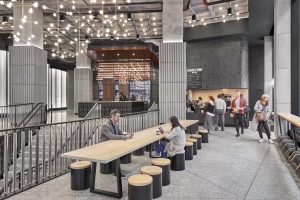
Enhanced E-Commerce
With the rise in e-commerce sales and third-party delivery services, it is more important than ever before to streamline logistics for those living in multi-family communities. Think cold and warm food storage for meal prep subscription boxes and third-party food delivery services, in addition to more dedicated storage space for packages. These secure, designated areas are not only efficient for picking up items, but must also be appealing to spend time in.
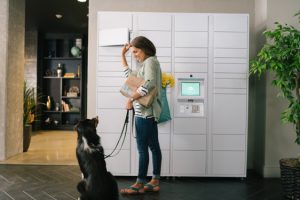
Work-Life Unity
Working from home will perhaps be the most significant byproduct of COVID-19. As office footprints start to condense, multi-family units will need to increase their square footage to accommodate at-home offices and privacy from pets and children. Elevated, co-working spaces throughout the building, both indoor and outdoor, will also need to be a seamless option. Co-working amenity spaces offer an avenue to get away from the home office, ensuring the ability to separate the office from home if desired.
Doorman-Style Details
As consumers have become accustomed to expanded service offerings and the ease of digital convenience, multi-family developments will need to elevate their customer service, adding a heightened level of hospitality. With more residents spending time at home, the value of convenience will differentiate a development for the better. Ride-share lounges, flexible, all-season entertaining space, bike storage, and even in-house bars or restaurants as part of the clubhouse experience, will go a long way in supporting resident’s newly adjusted lifestyles.
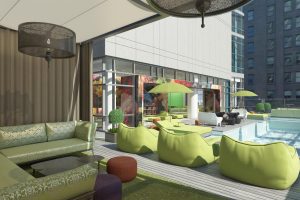
NELSON Worldwide Rendering – W Element Dual-Brand Hotel, Philadelphia, PA
Well-being Over Wellness
It’s important to recognize the pandemic as a significant hardship, knowing that residents will be dealing with stress, anxiety, or even stages of grief. Going forward, it will be crucial to create environments where people feel safe, productive, and supported. This desire for emotional support will drive well-being to take precedent, going beyond physical wellness, including mental and even financial health, activating amenities like meditation rooms, on-demand financial counselors, child care offerings, increased outdoor space, or even virtual therapy. While WELL certified is the gold standard, expect to see new certifications come to fruition to address these changing resident expectations.
The Great Outdoors
Much like other trends that have rapidly accelerated due to the pandemic, private outdoor spaces for multi-family buildings have always been desired, but the pandemic has made them critical. With more people spending time at home than ever before, having an outdoor escape has become essential – it becomes the new third space – an oasis from work, an untraditional office, the local watering hole, or even the gym. The revelation is to make these spaces more flexible, creating as much open-air space as possible, not only for a sense of well-being, but for a boost in mental health, and the freedom to access fresh air on-demand.
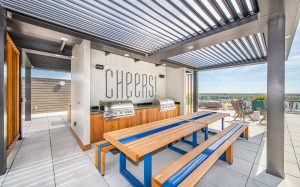
Deca Apartments – Greenville, SC
Communal outdoor amenities must evoke a sense of community, while still offering the potential of individual space or small group engagement. Rooftop decks will continue to be a hot commodity, for this reason, allowing easy access to an outdoor oasis with hybrid spaces for privacy and community. A development that can provide adaptable, outdoor spaces that offer an element of surprise or delight – whether it’s a good view, built-in entertainment, or extended workspace – will continue to stand out in the market.
Finally, residents want an elevated, furnished balcony to relax, unwind, and entertain – it should seamlessly support those activities, created with outdoor food and beverage consumption in mind. And because most multi-family buildings invest in state-of-the-art fitness centers to attract tenants, an outdoor balcony is usually never used for anything more than yoga or meditation.
Earth Day: Q & A with David Hincher
April 22, 2022 is Earth Day, but NELSON Worldwide is committed to sustainability year round. Not only do we design projects with the environment in mind, but we have also pledged to reduce our carbon footprint in our offices across the country. Director of Sustainability, David Hincher explains our green efforts.
Q: Does NELSON have any specific projects (in addition to W Element) that are sustainable in design? Any LEED-certified projects? If so, please specify how the project supports a sustainable framework.
NELSON’s Philadelphia office is designed and pursuing WELL and LEED certification. Office lighting and mechanical systems are synchronized with work patterns as occupancy sensors modulate quantity of lighting and indoor air quality. Natural daylight, a living green wall, meditation room, healthy snacks, were also included to promote employee health and well-being.
Q: How does NELSON comply with local sustainability law/policy to reduce its carbon footprint?
From across all geographic regions, local energy codes, and areas of practice, we bring lessons in high performance design to minimize energy consumption in every project. Daylight monitoring, lighting-dimming controls, occupancy sensors, modulating mechanical systems, continuous insulation, low-e glazing, external shading, etc. are optimized for performance and occupant comfort.
Q: How is NELSON addressing global climate change through architecture and design? Any notable practices to highlight? Any materials that the team prefers to use?
To address climate change, NELSON focuses on minimizing energy consumption through high performance design strategies, which reduces operational carbon emissions. In addition, we look for low-carbon, healthy, natural building materials to address embodied carbon emissions. These are two key factors to mitigate climate change.
Q: What are some of the firm’s goals when it comes to supporting a sustainable built environment?
In addition to climate change mitigation, we look for opportunities to build resiliency, integrate biophilic principles, create biodiversity, and manage stormwater.